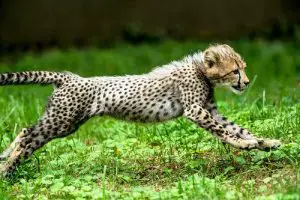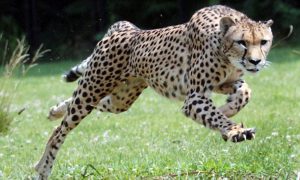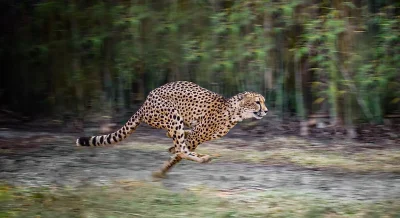What is the top speed of a cheetah?” This question sparks curiosity and conjures images of one of the fastest land animals on the planet, renowned for its incredible speed and agility. The cheetah, a majestic big cat native to Africa, has long fascinated both wildlife enthusiasts and scientists alike.
In this article, we delve into the realms of biology and natural history to uncover the secrets behind the cheetah’s remarkable speed, answering the age-old question: How Far Can A Cheetah Run In 1 Minute?
What is the top speed of a cheetah?

The cheetah is the fastest land animal, capable of reaching speeds that leave most other creatures in the dust. A cheetah can accelerate from 0 to 60 miles per hour (97 kilometers per hour) in just a few seconds, covering short distances with astonishing speed.
The top speed of a cheetah is approximately 75 miles per hour (120 kilometers per hour). This remarkable velocity allows these sleek and powerful predators to pursue and capture their prey with exceptional efficiency, making them a marvel of nature’s design.
How fast can a cheetah run in miles per hour?
A cheetah is known for being the fastest land animal, capable of reaching speeds up to 60 to 70 miles per hour (97 to 113 kilometers per hour) in short bursts covering distances up to 500 meters (1,640 feet). These incredible speeds make cheetahs highly effective predators, as they use their speed and agility to chase down prey.
Several factors contribute to the cheetah’s impressive speed. They have a lightweight and streamlined body, long legs, and a flexible spine, which collectively aid in rapid acceleration and high-speed pursuit. Additionally, the cheetah’s respiratory and cardiovascular systems are adapted to support the intense physical exertion associated with sprinting.
However, it’s important to note that these high speeds are unsustainable for extended periods. Cheetahs can only maintain their top speed for a short duration due to the tremendous energy expenditure and the resulting buildup of heat in their bodies. After a sprint, a cheetah typically needs a significant amount of time to rest and recover before it can engage in another high-speed chase.
Can a cheetah maintain its top speed for a minute?
No, a cheetah cannot maintain its top speed for a full minute. While cheetahs are incredibly fast and can reach speeds of 60 to 70 miles per hour (97 to 113 kilometers per hour), they can only sustain these high speeds for a short burst—typically around 20 to 30 seconds.
The reason for this limitation is the intense physical exertion and energy expenditure associated with running at such high speeds. The cheetah’s body generates a significant amount of heat during a sprint, and their respiratory and cardiovascular systems are not designed for prolonged endurance at these speeds. After a brief sprint, a cheetah needs to rest and recover to avoid exhaustion and overheating.
During a chase, a cheetah relies on its incredible acceleration and top speed to catch prey quickly. If the initial sprint is unsuccessful, the cheetah may abandon the chase to conserve energy for the next opportunity.
How does a cheetah’s running speed compare to other animals?

The cheetah is the fastest land animal, and its running speed far exceeds that of most other animals. Here are some comparisons:
- Cheetah vs. Human:
-
- A cheetah can reach speeds of 60 to 70 miles per hour (97 to 113 kilometers per hour), which is much faster than the top speed of the fastest human sprinters, who typically reach speeds of around 28 miles per hour (45 kilometers per hour).
- Cheetah vs. Other Big Cats:
-
- Cheetahs are significantly faster than other large cats. For example, lions and tigers are powerful predators but are not built for speed. Their top speeds are around 35 miles per hour (56 kilometers per hour) for short distances.
- Cheetah vs. Prey:
-
- Cheetahs are adapted for chasing down fast prey. While they can outrun most animals, their main targets include gazelles and impalas, which can also reach impressive speeds but usually can’t match the sustained speed of a cheetah over short distances.
- Cheetah vs. Dog:
-
- Domestic dogs, depending on the breed, can have varying speeds. Greyhounds, one of the fastest dog breeds, can reach speeds of around 45 miles per hour (72 kilometers per hour), making them fast but still slower than a cheetah.
- Cheetah vs. Horse:
-
- Horses are fast runners, and their top speed can vary by breed. Thoroughbred racehorses, for example, can reach speeds of around 40 to 45 miles per hour (64 to 72 kilometers per hour), which is notably slower than a cheetah.
What factors contribute to a cheetah’s impressive speed?
The cheetah’s impressive speed is the result of a combination of physical and physiological adaptations that make it an exceptional sprinter. Here are some key factors that contribute to a cheetah’s speed:
- Body Structure:
- Cheetahs have a lightweight and aerodynamic body with long legs and a flexible spine. This streamlined physique reduces air resistance and allows for efficient forward motion.
- Muscle Structure:
- Cheetahs have powerful muscles, particularly in their hindquarters, which provide the strength and force needed for rapid acceleration. The large hip and thigh muscles generate the energy required for explosive sprints.
- Stride Length:
- Cheetahs have an elongated body and long limbs that contribute to an extended stride length. A longer stride allows them to cover more ground with each step, maximizing their efficiency in pursuit.
- Foot Design:
- The cheetah’s feet have specialized pads and claws. The foot pads are hard and less rounded than those of other big cats, providing traction and grip during high-speed chases. The non-retractable claws act like cleats, providing additional traction.
- Respiratory System:
- The cheetah’s respiratory system is adapted to support the oxygen demand during high-speed chases. Large nasal passages and lungs allow for rapid intake of oxygen, facilitating efficient respiration during intense physical activity.
- Cardiovascular System:
- Cheetahs have a highly efficient cardiovascular system. Their heart pumps an increased volume of blood to supply oxygen and nutrients to the muscles during sprinting. The large arteries and veins help maintain a steady flow of blood.
- Temperature Regulation:
- Cheetahs are vulnerable to overheating due to the intense physical exertion involved in sprinting. To manage this, they have evolved to dissipate heat quickly. They pant heavily after a sprint to cool down and have large nasal passages for rapid air exchange.
- Specialized Vision:
- Cheetahs have excellent eyesight, which helps them spot prey from a distance. Their binocular vision allows for accurate depth perception, crucial for targeting fast-moving prey during a chase.
- Nervous System:
- The cheetah’s nervous system is finely tuned to coordinate rapid movements. Their ability to make split-second decisions and adjust their trajectory during a chase is crucial for successful hunting.
These adaptations collectively make the cheetah a specialized and highly efficient predator for short, high-speed pursuits, allowing it to catch and bring down prey with remarkable agility and speed.
How long can a cheetah sustain its high-speed chase?

Cheetahs are capable of reaching impressive speeds, but their high-speed chases are relatively short-lived. Typically, a cheetah can sustain its top speed for about 20 to 30 seconds, covering distances of up to 500 meters (1,640 feet). This burst of speed is usually sufficient to close the gap between the cheetah and its prey.
There are several reasons why cheetahs cannot maintain their top speed for an extended period:
- Energy Expenditure: Sprinting at high speeds requires a significant amount of energy. The cheetah’s body generates a tremendous amount of heat during a sprint, and it expends a substantial amount of energy in a short period. Prolonged running at such high speeds would lead to rapid fatigue and exhaustion.
- Heat Buildup: Cheetahs are vulnerable to overheating due to the intense physical activity involved in a chase. Their bodies can quickly reach high temperatures, and extended exertion would risk overheating, potentially causing harm to the cheetah.
- Limited Oxygen Supply: The cheetah’s respiratory system, while adapted for rapid oxygen intake, has limitations. Sustaining top speed for an extended duration would challenge the cheetah’s ability to maintain the oxygen supply needed for its muscles.
After a high-speed chase, a cheetah typically needs a significant amount of time to rest and recover. Successful or not, the chase is followed by a period of panting to cool down, and the cheetah may rest for an extended period before it can engage in another sprint.
This strategy allows the cheetah to conserve energy and avoid the risks associated with prolonged, high-speed pursuits.
Variations in the running abilities of different cheetahs
While all cheetahs share a common set of adaptations that make them exceptional runners, there can be variations in the running abilities among individual cheetahs. These variations can be influenced by factors such as age, health, genetics, and individual fitness. Here are some considerations:
- Age and Experience:
- Young cheetahs may not be as skilled or experienced in hunting as older individuals. With practice and age, a cheetah may improve its hunting techniques and running efficiency.
- Health and Fitness:
- The health and physical condition of a cheetah can significantly impact its running abilities. Injuries or health issues can affect a cheetah’s speed and agility. A well-nourished and healthy cheetah is likely to be more effective in a high-speed chase.
- Genetics:
- There can be genetic variations among individual cheetahs that influence their running capabilities. Some cheetahs may inherit genes that contribute to greater speed or endurance.
- Territorial Factors:
- Cheetahs living in different regions may face varied environmental conditions, which could affect their running abilities. Factors such as terrain, vegetation, and altitude may influence how cheetahs utilize their speed in hunting.
- Individual Temperament:
- Cheetahs, like any other species, may have individual variations in temperament. Some individuals may be more aggressive or assertive in their hunting strategies, potentially affecting their success in a chase.
- Environmental Factors:
- The environment in which a cheetah lives can play a role in its running abilities. For instance, a cheetah in an open savanna may have more opportunities for high-speed pursuits compared to one in a densely vegetated area.
- Training and Learning:
- Cheetahs learn to hunt from their mothers and through trial and error. The learning process can influence how effectively an individual cheetah uses its speed in a hunt.
It’s important to note that while individual variations exist, cheetahs, in general, are highly specialized for speed and agility.
They are among the most accomplished sprinters in the animal kingdom, capable of reaching remarkable speeds for short bursts. These variations contribute to the overall diversity within the cheetah population, allowing for adaptation to different environments and conditions.
Conclusion
You want to know How Far Can A Cheetah Run In 1 Minute, we have all you need to learn here.
In a one-minute sprint, a cheetah can cover distances of up to approximately 500 meters (1,640 feet) at its top speed, which ranges from 60 to 70 miles per hour (97 to 113 kilometers per hour). However, it’s important to note that a cheetah cannot sustain this high-speed chase for the entire minute.
The intense physical exertion, energy expenditure, and the risk of overheating make these sprints relatively short, typically lasting around 20 to 30 seconds. After such a burst of speed, the cheetah requires a significant rest period before it can engage in another high-speed pursuit.


